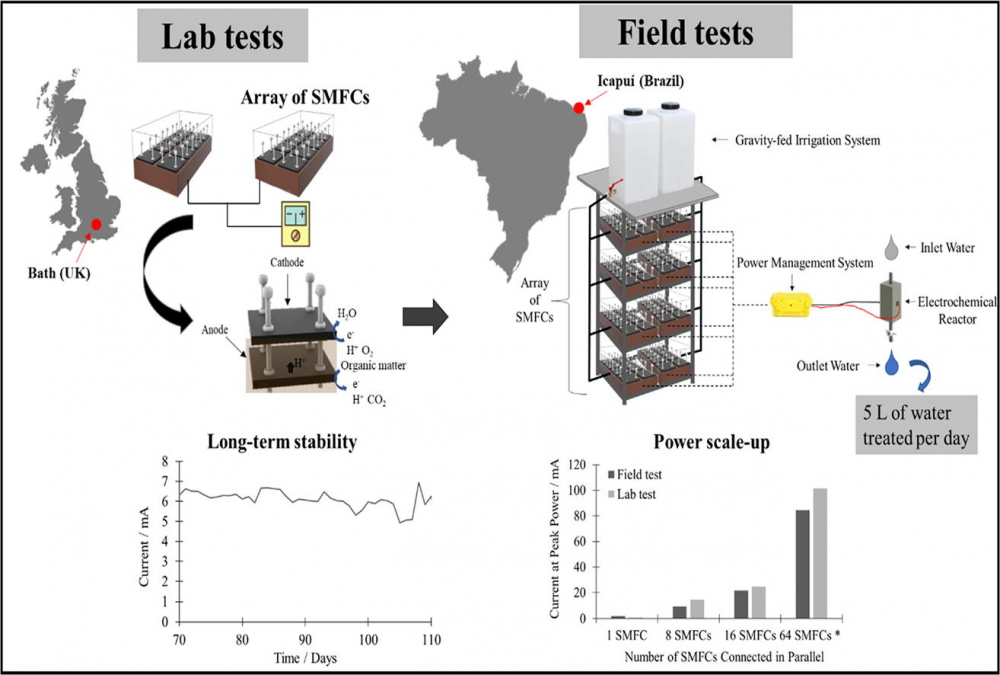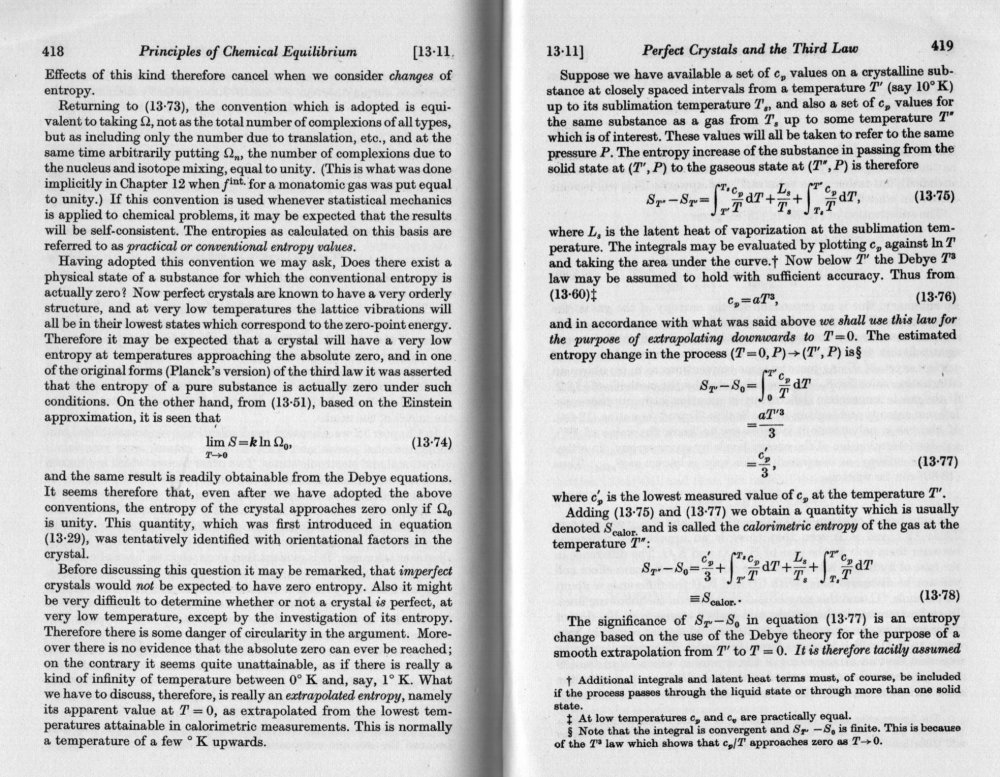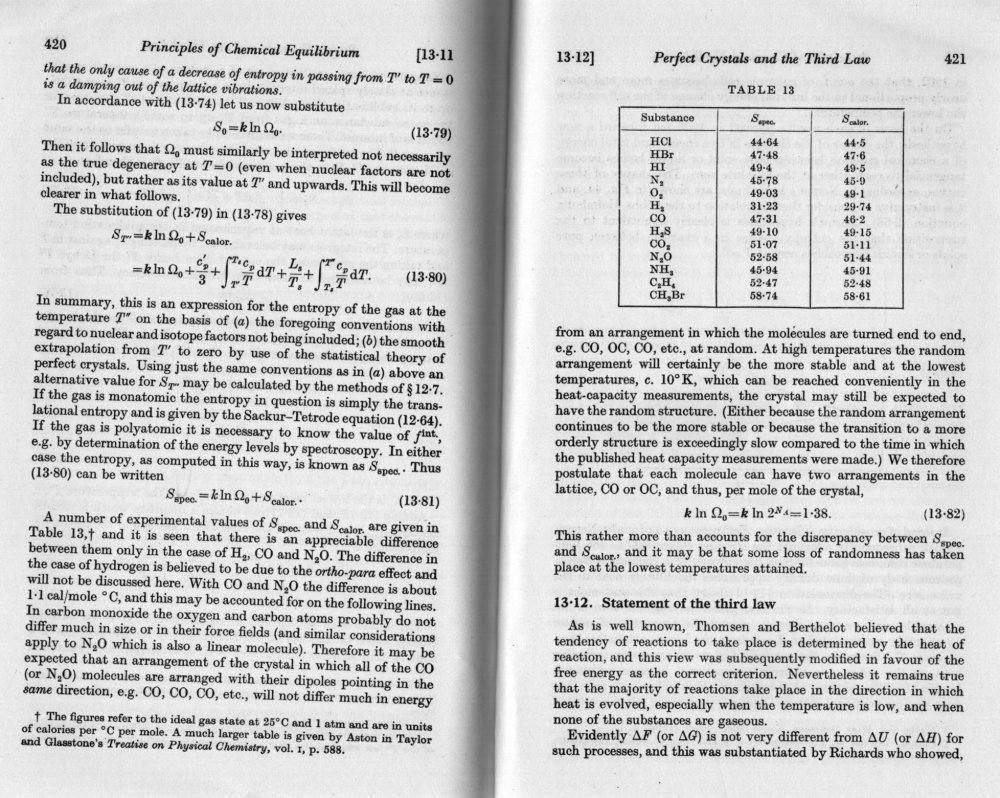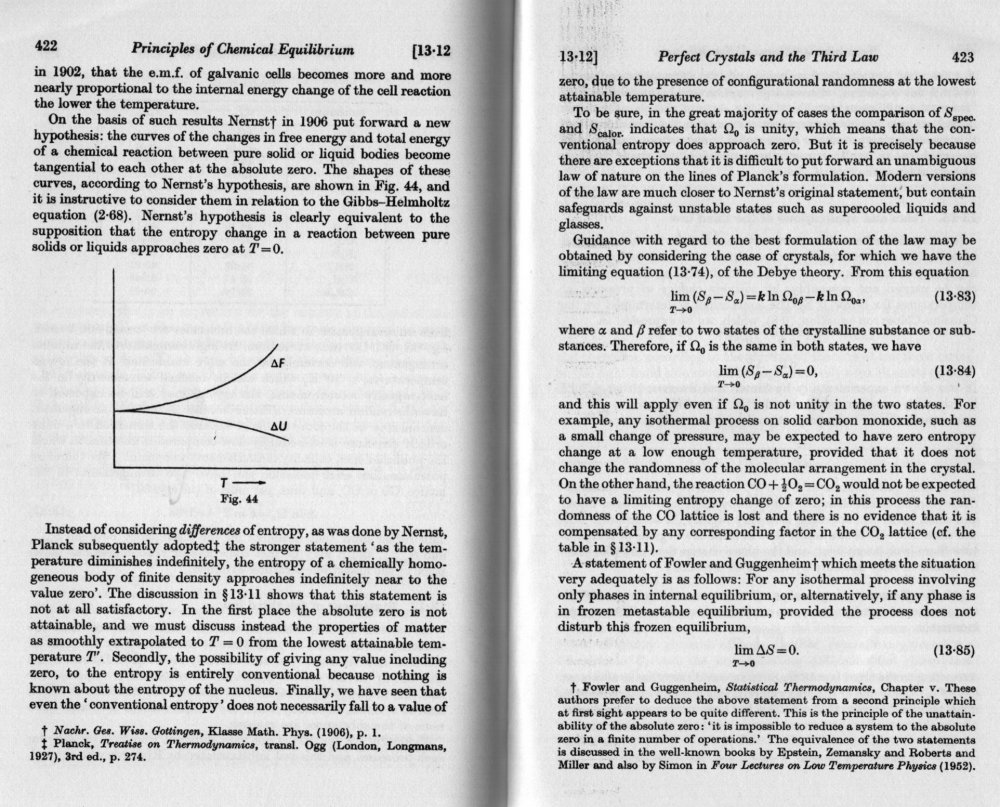

exchemist
-
Posts
3378 -
Joined
-
Last visited
-
Days Won
50
Content Type
Profiles
Forums
Events
Posts posted by exchemist
-
-
8 minutes ago, raphaelh42 said:
I mean you stay in the air but don't move
I didn't know, I'm very surprised
I was thinking about why the not moving things in the air would rotate the same as the Earth does, and not just arrive to the opposite location after 12 hours, or just arrive elsewhere
If I understand correctly, since Earth's rotation influences the travel duration of aircraft, there is a positive speed value that would never allow you to reach B point?
One that would make you just stay at the same location? And one that would make you go backwards? (but with this one you would reach B)
Imagining the aircraft doesn't have a minimal speed value to respect for not falling
The atmosphere, broadly speaking, rotates with the Earth so to a first approximation the rotation does not make anything suspended in the air move, relative to a point on the ground. If this were not so, you would feel a constant wind, always from the same direction, due to the difference in rotational speed between you, on the ground, and the air.
When it comes to second order effects, the rotation of the earth plays a role in determining various patterns of air flow in the atmosphere, e.g the jet stream, the trade winds, etc.
But do not imagine these are simply due to a difference in rotation rate between the surface and the air above. The jet stream, for instance, flows from west to east, the same direction as the rotation of the earth, but faster, thereby creating a west-east wind, relative to the surface. This and many other air flows arise from a combination of heating and cooling in different parts of the globe with the effects of rotation, via Coriolis effects and so on.
0 -
1 hour ago, Bloop E0 said:
One component of the index takes into account regional discrepancies and constitutes a two-tier system.
1) A system that uses UN as a reference point
2) A system that uses regional conventions as a reference point, such as
• Council of Europe (represented by European Court of Human Rights)
• Organisation of American States (represented by the inter-American system for the protection of human rights)
• African Union (represented by African Commission on Human and Peoples’ Rights and the recently-established African Court on Human and Peoples’ Rights)Self-regulating mechanism itself is not attempting to impose international order or human rights standards. Based on the minimal permissible level of implementation of human rights, it allows each country individually to adapt the standards to its national context influenced by socio-cultural, economic and other characteristics.
All of these issues have already been taken into account.Of course it will capture their imagination 🤨
We're not talking about the Index, we're talking about turning the Index into action.
The basic (grassroots) condition for self-regulation is not only in the field of preserving rights, freedoms and environment, but also lies in the financial interest of billions of people (ex. algorithm: “basic income” in exchange for civil engagement, education, self-enlightenment, participation in the network of independent scientists, etc.). We all know that the human brain needs to be motivated : ) … offer your options for motivation.
Human of the Future – a human who is a researcher, who is motivated by education and enlightenment, who daily creates influence by his actions, research, self-enlightenment and self-education on the formation of the civilization efficiency index and the civilization development index, and ultimately directly affecting the socio-economic mechanism and progress.The point is that every state must participate in civilisational progress. And all the more reason not to prevent its citizens from participating in this process
These were very good recommendations in the "it's not possible" format. Now it would be nice to move on to "maybe this is how" recommendations 🙃
How would your proposed index be an improvement on this?:
0 -
39 minutes ago, Bloop E0 said:
I'm working on an independent research of social technology “civilisation efficiency index” and “index of a civilisation’s development”.
Interesting to hear opinions on the issues:
- What can/should be present in this index? (ex. integration of the algorithm which is making it difficult for politicians to use the “demagogy of pessimism” (regulatory function in relation to accessibility heuristics) or finally start teaching quantum physics from the first grade of primary school)
-How do you see the algorithm for the Index? General recommendations.Proceed on the basis of the following assumptions
Main aim is not only to create and calculate the Civilisation Efficiency index, but also through multi-stage, varied and decentralised social and financial mechanisms to allow billions of people to influence the Index.
Let's call it a "self-regulating social mechanism". The aim of the self-regulating social mechanism is to convert the Index into tangible action and measurable progress. A self-regulating social mechanism is a people’s (and humanity as a whole) against a potentially dangerous imbalance in institutions and the political structure that can threaten not only an individual state but the whole world. It's like a stabilisation system in a car to reduce the possibility of driving into a ditch. Or a kernel protection system in computer and or decentralisation in blockchain.
And of course is the development of resilient societies, as well as mechanisms for these societies to transition into a group of active creators (evolution of "inertial progress" societies)I have some material and thoughts on the subject. But first I would like to hear outside opinions.
I think trying to reduce the host of factors that comprise a desirable civilisation into a single index is not likely to be successful. I am not convinced all the peoples of the world want or expect the same things from their civilisation or society and I don't think publicising a single index with periodic rankings will capture their imagination. I think people are more interested in indices that reflect specific aspects of a desirable society, for instance an index on press freedom, or on the opportunities available to women. Such things have a clear meaning, whereas a single index putting everything into one pot will not.
I also think the term "civilisation" is not the best to use in the context of social development. "Civilisation" encompasses a huge mass of factors: history, language, traditions, religions, moral codes, as well as modes of social organisation, institutions, political systems etc. If, as it appears, you are trying to create an index to rank some form of social progress, you are not talking about a lot of this and indeed a lot of it cannot be ranked in an index at all. So if I were you I would talk of "society" and not "civilisation.
0 -
6 minutes ago, Vette888 said:
The ekpyrotic model proposes that the universe has no beginning or end. Instead of a bang, what happened is thought of as a "Big Bounce", the moment at which the universe, which was slowly contracting to an incredibly, but not infinitely, small point, bounced to expansion. There is no beginning of time. Instead, our visible universe exists on one of two four-dimensional "branes" floating in a five-dimensional space.The ekpyrotic universe theory asserts that the cosmos exists as a product of an endless procession of creation, destruction and recreation. This model theorizes that the universe has been expanding and contracting repeatedly over time scales that make the 13.7 billion years that have passed since the Big Bang seem like a second.
What do you want to discuss?
0 -
20 hours ago, Markus Hanke said:
I’m not so sure about this, because it doesn’t seem clear to me at all that/why there should be ‘something’ that is ontologically distinct from an interaction. If there is, then we have never observed it directly - any perception, any measurement, any experiment we can perform always boils down to interactions, at the most fundamental level. Even if there is ‘something’ there, then all we can ever see is the interface it exposes to its environment - and this tends to be highly contextual, especially in the quantum realm. Based on human intuition we tacitly and naturally assume that if there’s an interaction, there needs to be ‘something’ there that interacts, but I’m not so sure.
But of course, these are just philosophical musings of mine (even if they do, as you correctly observe, gel well with Rovelli et al), so I might well be entirely wrong

All I mean is that the word interaction implies an event involving more than one entity. It is an action "inter", i.e. between, entities. What is interacting? There have to be somethings to interact, or it is wrong to describe the phenomenon as an interaction - it would just be an event.
Clearly something is there in between (which we may describe by a wave function for example), sufficient to render the next interaction predictable. If there were nothing, there would be no predictability about the next interaction. So it seems to me it is the nature of that something that is up for debate.
0 -
4 minutes ago, katahiromz said:
They say the Universe is expanding since the big bang.
However, relatively thinking, is it possible that we and our scale are shrinking?
S u r e l y n o t.
1 -
3 hours ago, Markus Hanke said:
Nice way to look at it.
Though I would perhaps even go a step further and say that physics models describe how things relate to other things, wherein the term ‘things’ is to be understood in its most general and abstract meaning. So perhaps it would be far better to look at reality as a network of interactions and relationships, rather than a collection of ‘stuff’ that’s doing things.
It’s a bit like the concept of motion - it’s a very useful concept in order to describe certain aspects of the world, but it has no fundamental, ontological reality in and of itself, unless viewed as a relationship between things. I’d like to suggest that perhaps other aspects of reality are similar, though in less obvious ways.
That view - of reality as a network of interactions and relationships - seems to fit well with Rovelli's relational interpretation of QM. But as it is those interactions and relationships that our mathematics models, such a view of reality implies that what we are doing (or should be doing) in science is to model a physical reality. And to go further, if we model interactions, there have to be some entities that interact, whether or not they can be said to have continuous existence in between.
I may be in a minority, to judge by the other comments from the physicists here, but I suppose I am a bit of a Baggotista on this, cf. Jim Baggott's slightly provocative book "Farewell to Reality". (Full disclosure: I worked with him for a while when we were at Shell. Admittedly we are both chemists rather than physicists, which may colour our perspective.)
0 -
7 minutes ago, geordief said:
It is a faith but an overwhelmingly convincing one.
Does it make a point to ask whether "reality" describes something set in stone or something continuously changing ,even if imperceptibly.?
Off topic I find it more rewarding and satisfying to weed out what is "unreal" than to home in on what may be considered essentially true.(well I don't have the intellect for the latter ,anyway)
Ah well, what can be said to be "true" is another kettle of fish entirely. In science one tends to avoid bald truth statements. for the standard Popperian reason, viz. "truth" in science is only provisional. But the statements we make, with whatever caveats, are nevertheless about something that we think is real, I would say.
0 -
39 minutes ago, swansont said:
Whenever this comes up, the distinction of what one means by real needs to be made: real as opposed to fantasy/fictitious, or real in the sense of physical existence vs concepts. These aren’t completely orthogonal thoughts, but the latter is a better description IMO. Much of physics is comprised of calculational conveniences. Math, for example, is conceptual, but it’s not fiction.
A photon or a phonon doesn’t need to physically exist to be useful to describe the relevant behavior. How would one tell if they do, since all we can do is look at experimental results? It’s like Plato’s allegory of the cave.
Yes I agree it is about what one means by "real". I would contend that those calculational conveniences, and more importantly the concepts which we relate to one another in our calculations, do in the end purport to tell us something about physical existence, i.e. what we think is real, even if they do not claim to be definitive. Otherwise why bother? I think the scientist must believe there is an objective reality out there to be modelled, or he or she would not make the models.
To borrow from St. Paul, we may "see through a glass darkly", but surely we have to think we are dimly perceiving something real, don't we?
1 -
45 minutes ago, swansont said:
“Yes, everything in physics is completely made up – that’s the whole point”
https://www.sciencefocus.com/news/everything-physics-made-up/
Is it ever true, then, to say that an electron is ‘real’ when it’s in motion? If we believe that electrons are real things, have we just made up the wavefunction to make the math work out? Absolutely – that was, in fact, the whole point. We couldn’t get the equations to work if the electron was a solid, isolated particle, so we made up something that wasn’t, and then the numbers started making sense.
…
physics isn’t built around ultimate truth, but rather the constant production and refinement of mathematical approximations. It’s not just because we’ll never have perfect precision in our observations. It’s that, fundamentally, the entire point of physics is to create a model universe in math - a set of equations that remain true when we plug in numbers from observations of physical phenomena.
Another physicist’s take on physics describing behavior vs reality
Yes, up to a point. However I always dislike the tendency to make out physics is all about maths. Physical concepts come before, or simultaneously with, the maths. You have to describe an electron and its properties in words before you can do any maths involving it. So yes, physics makes mathematical models, but the building blocks that the maths connects and manipulates are concepts of physical entities and their attributes that are, of necessity, described in words.
The writer quoted also seems to me to somewhat evade the issue about "reality" when she says the wave function is "made up". That suggests it is a fiction. However the fact that this made up maths fits the observations so well shows it is a model of reality that is pretty accurate. So while no one would claim a wave function "is real", the wavelike behaviour it describes does at least represent an aspect of reality.
0 -
2 hours ago, joigus said:
Are we done here?
I bloody well hope so! 😁
1 -
38 minutes ago, John Cuthber said:
When you get cold enough for spin energy to be significant, most things (including nitrogen) have already frozen solid.
So you don't get the same effects that you see with hydrogen and deuterium (and, I guess, tritium if you have any).Indeed. However, if there is 5-fold degeneracy in the rotational levels (in the ortho spin isomer), would that not be expected to affect the gas phase molar entropy?
0 -
3 hours ago, lessthannovice said:
Thank you for the help. Sorry it didn't occur to me to start a new thread. I actually stumbled across this forum because this thread came up as a search result when I was using a search engine to try to find an answer to my question. I wasn't holding out much hope to get an answer, so thank you for the pleasant surprise. You proved my hunch that real people who have put in the time to study a subject are more reliable than a search engine.
By the way, is it true that as a rule, something that is soluble in water will usually be soluble in glycerin, too?
It's best not to think of solubility in black and white terms. There are degrees of it. I don't know for a fact, but my guess would be that glycine has appreciable solubility in glycerol, but less than in water. I would expect the same to be true of many other polar compounds.
When it comes to ionic compounds (inorganic salts) it may be a more complex picture, depending on the success that a big molecule like glycerol has in binding to a small, charged ion. Others here may have more knowledge of this than I do.
But directionally yes, glycerol, being polar, should be able to dissolve polar species significantly.
1 -
58 minutes ago, studiot said:
Interesting. The BBC article doesn't explain how it works but I've found this paper with an abstract and a diagram that help explain this:
https://www.sciencedirect.com/science/article/abs/pii/S0306261920311776
Here is the diagram:
It seems from this that these microbes generate CO2 and H+ ions by decomposing organic matter below the surface of the soil and in the process release free electrons (!). The electrons are captured by the anode of the circuit.
The cathode lies on the soil surface, which is exposed to oxygen in the air. There, H+ ions are combined with oxygen plus electrons from the cathode to produce water. So the net effect is oxidation (electron removal) of the organic matter, producing CO2 underground and water on the surface.
The slight mystery is that this paper is from 2 years ago, so it seems unclear why the BBC has decided to report it as news only now.
1 -
1 hour ago, sethoflagos said:
Check entropy of mixing. The slightest difference in particle properties produces a significant step change in entropy irrespective of the degree of difference. It's this aspect that got me thinking about these spin isomers in the first place. Again: Gibbs' Paradox.
Well then, since the spin of ¹⁴N is +1, that of ortho N2 will be +2, with potential components +2, +1, 0 -1, -2, so 5-fold degeneracy, vs single states for the para version. I suppose this should show up in entropy calculations for nitrogen in some way.
0 -
8 hours ago, sethoflagos said:
Now I can sleep with an untroubled mind!
I suppose there are also in theory spin isomers of other diatomic gases. But probably the spacing between rotational levels is too small for this to produce discernable effects. It’s something I’d never previously thought about.
0 -
25 minutes ago, sethoflagos said:
I'll have to sleep on that one. When I wake up may be I'll have figured out how what you said was different to what I said. Thanks nevertheless!
Ah the light dawns - maybe. I didn't realise that by "extra degrees of freedom" you might have in mind the 3-fold degeneracy of the triplet rotational states. If so then, er, yes, we're saying the same thing!
0 -
7 minutes ago, geordief said:
Would it (the time dilation)slow the speed of the conversation down without affecting the pitch? (Maybe it would affect the pitch too)
Would there be a particular relative speed where the doppler speeding effect would exactly counterbalance the relativistic time dilation slowing effect?
No. The pitch is determined by the rate at which successive peaks and troughs in the sound waves arrive. The starting and stopping of every syllable of the conversation will also arrive at the same rate, since both are determined by the speed of sound relative to the receiver.
0 -
15 minutes ago, geordief said:
Well ,not by later recovering a recording of any conversation (that is obvious ,I suppose)
But hopefully using whatever method comes closest to how we listen or watch something in our own frame of reference (there is forcibly a delay )
So in my mind ,for the approaching spacecraft I imagined us sending a laser beam against perhaps a window and capturing a recording of the window's vibrations in the light that was reflected back to the emitter.
For the plane travelling just below the speed of sound I had a similar (same) method in mind
So ,as "directly "as possible (perhaps there are better methods?)
In general I think the Doppler effect would speed up the conversation, just as it would raise the pitch of the speakers. Relativistic time dilation is another thing.
0 -
1 hour ago, sethoflagos said:
I found the discussion of J state populations a bit hard to follow. Is the 75% ortho equilibrium limit simply due to equipartition amongst these extra rotational degrees of freedom, or is there more to it than that?
Hmm, I see what you mean. There are no extra degrees of freedom, though. Diatomic molecules all have 2 rotational degrees of freedom. But ortho can only populate odd numbered rotational energy levels while para can populate only even levels. I had to look this up (it's badly explained or not explained in Wiki) but it appears the issue is that ortho hydrogen is a triplet state, in which the total nuclear spin of 1 can be orientated +1, 0 or -1 with respect to the axis of rotation, thereby multiplying the numbers of rotational states available by 3, i.e. each rotational level has 3-fold degeneracy, whereas the para states do not. So at RTP, with kT>> ε for rotation, you end up with a 3:1 ratio, just because there are more ways for ortho to have a certain amount of rotational energy.
I think that's it, at least.
1 -
4 hours ago, Michael McMahon said:
Restaurant food is cooked by a professional and might always taste nicer than home food. As such ordering healthy food in restaurants would make it easier to eat healthier at home. There's no harm in the odd indulgence in fast food at restaurants. Yet ordering too many burgers at restaurants would then make fast food more tempting for home dishes. The dilemma is that restaurants can be seen as a form of recreation if someone eats out seldomly. Yet there might be more reward to choose heathy dishes from the menu for those who eat out rarely. I've tried to desensitise myself to porridge through jams and fruit by ordering it frequently for breakfast at a restaurant:
It seems to me it's actually quite hard to simulate fast food crap in home cooking. Things like burgers generate massive amounts of smoke, while fried stuff requires a deep fryer and huge amount of oil, which is a nuisance to dispose of. Pizzas are really hard to make, at least if you want a proper pizza base to them, rather than a fake pre-made thing.
Cooking proper, simple things at home is quite likely to result in you eating healthily. It is ordering stuff in, because you can't face cooking for yourself, where the problems often seem to start.
0 -
1 hour ago, studiot said:
Very quickly before I head for the bank
Part 3 of Callen Thermodynamics and Thermostatistics
pages 455 - 471
Callen goes through modern interpretation of the quantum angular momentum rules via Noethers theorem (symmetries), Goldstone's theorem (broken symmetries) and gauge symmetries in relation to accessible and inaccessible microstates of a system and the state space of a system.
The quantum rules forbid certain transfers of angular momentum which leaves ortho and para hydrogen as essentially different gases in a mixture.
For a while at least. Though from what I read, the rotational J=1 state of ortho does eventually relax to J=0 as the ortho gradually converts to para, by the various non-radiative means of relaxation we have been discussing.
0 -
20 minutes ago, studiot said:
Glad it worked out for you!
It was late and I was rushed last night.
One of the very first books I bought at university back in 1968 was Denbigh's Chemical Equilibrium.
He gives a much wider treatment of these effects both from a fugacity/Chemical Potential point of view (P1`22 - 132) and also form a statistical/calorimetric entropic point of view.
Here are some pages of the latter which may be of interest since they cover a much wider range of gases that just hydrogen.
The note at the bottom of p420 refers to Glasstone - an earlier work from 1940 - on page 588
My 1951 second ed has that material at the beginning pages 94 - 97 entitled Ortho and Para States.
This may be more accessible for you as it is american.In deference to your opthalmology I have increased the scan deoth, although it means a larger file size.
Yes I agree, the standard chemist's method of avoiding mechanical mechanisms is to go the least energy/ least action route.
Another good reference is
Wilson Thermodynamics and Statistical Mechanics 1966
Chapter 6 Specific Heats
p 139ff
6.12 The Rotational Specific Heat of Hydrogen
The problem with trying to tackle it mechanically is that means quantum mechanically.
What has happened is the wave functions of the orbital have become distorted by the nucleus being off-centre. One can't really speak of nice neat forces, acting between the nucleus and electrons as particles, in this scenario. So the energy approach, which is what the Hamiltonian does in Schrödinger's equation, seems to be the only way to describe what happens, so far as I can see.
I'm not sure how the heat capacity stuff relates to what we have been discussing. Can you elucidate?
0 -
8 hours ago, swansont said:
But such transitions could be induced in collisions
Yes....by creating the transitory fluctuations in magnetic field that I referred to.
6 hours ago, sethoflagos said:Getting back to the OP, how are the momentum and energy transfers in a collision actually transferred to the nucleus?
I can picture electrostatic repulsion and possibly even the Pauli exclusion principle acting on the electrons, but I struggle to picture the corresponding forces of repulsion acting on the positively charged nucleus.
Okay, I admit it, I've not the faintest idea of what keeps a nucleus centralised within the atom.
The way I think of it (rightly or wrongly) is like this. If you consider one nucleus, it is experiencing a magnetic field from the other one in the molecule, so it partially aligns, either with against that field. Standard space quantisation. In a collision, a 3rd nucleus comes up, just as close as the one to which it is bonded, maybe closer. So what magnetic field does the first nucleus now see? Some sort of resultant, with different alignment and different field strength. So it will now try to align with that. But this state has only transitory existence, so its energy levels will be poorly defined (uncertainty principle). And then after the collision the situation reverts to what it was before. But as a result of this there is a probability that the nucleus does not come out of the interaction with the same orientation in which it entered.
Regarding centralisation of the nucleus, the electron cloud is centred on the nucleus and if it moves, leaving the nucleus off-centre, the electron cloud becomes distorted, leading to a higher energy state, which is resolved by the nucleus re-centring itself.
1







i know you guys are all about math and physics. That is so funny to me. Math is simply logic and art or if you prefer logic and logic
in Speculations
Posted
Ah autism. That accounts for it. Possibly.